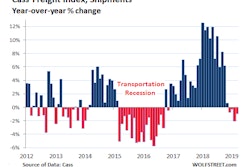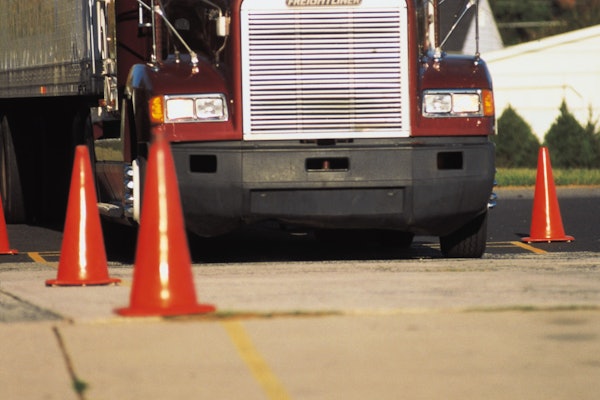
The final quarter of 2018 presented more mixed results for freight indicators than the roar of late 2017 and the first half of 2018. Still, rates remained near historic highs as trucking capacity held tight. As the year ended, the economy appeared stable despite that lull.
Little risk of a recession looms for 2019, with momentum from 2018’s booming first six months and tax cuts expected to carry the U.S. economy well into next year, says Avery Vise, vice president of trucking at FTR, a transportation research group. FTR analysts foresee a greater risk for a recession, even if a soft one, in 2020.
“I still don’t think it’s likely, but FTR has the probability at about 40 percent,” Vise says.
Whether it might come, a downturn more pronounced than the mild pullbacks of recent months is likely inevitable. Most economic expansions last on average five years, historically. The current cycle of economic growth, coming out of the 2008-09 recession, is now in its ninth year — the second-longest period of growth on record.
“It’s historically stale,” says economist Noël Perry, of Truckstop.com. “I think 2020 is going to be a bad year. We are clearly past the peak” of the current cycle, he says.
By late 2020, “we’ll be back at the capacity utilization level that we were at in 2016,” predicts Perry. He also expects spot market rates to enter a downslide next year, particularly in the later months.

Bill Strauss, senior economic adviser with the Federal Reserve Bank of Chicago, says the economy’s growth has been balanced during the nine years since the Great Recession’s end, but says there’s concern by some that “we’re due for a recession.”
A full-on recession aside, slower growth could cause rates to retreat to more normal levels. That could shave dimes off the $2.20-plus per-mile rates owner-operators have enjoyed over the past 18 months and put a big dent in revenue.
Owner-operators, especially those who’ve recently transitioned from company driver to leased owner-operator, or from leased operator to independent with operating authority, are perhaps most at risk. If they haven’t worked through a weakening market in their current status, they might not know what it takes to endure leaner times.
Here are five key areas to help any owner-operator lay the groundwork for survival.
1. Know your costs – and reign in spending
2018’s buoyed rates made it easier for owner-operators to neglect cost oversight and still turn a profit.
“When revenue is good, a lot of owner-operators focus on generating revenue and let expense management go out the window,” says Todd Amen, chief executive officer of owner-operator business services firm ATBS, which works with about 15,000 owner-operators.
Many operators “don’t realize that at good freight rates, they’re barely making a profit,” says Kevin Rutherford, former small-fleet owner and current owner-operator coach and host of Sirius XM’s “Trucking Business and Beyond” show. When rates do go down, he says, “they’re going to be in trouble.”
Rutherford urges owner-operators to know their costs and other operational benchmarks so they can gauge whether they’ll be able to stay profitable when rates slip. “If we go back to 2015, 2016, could you have survived during that time?” he says.
“The only way to know is to have a good accounting system. If you look at the numbers and can’t make it if the average rate goes back to $1.60 a mile, you’ve got to change your operation or get better fuel economy or lower costs,” he says. “You need to figure that out now before it happens.”
“The key is controlling costs,” says Gary Buchs, a veteran owner-operator from Colfax, Illinois, who runs for Landstar. “We can’t really control the market and what we receive,” he says of rates. “We have the most control over our spending.”
Buchs, named 2017 Owner-Operator of the Year by Overdrive and the Truckload Carriers Association, suggests operators make a spreadsheet based on their 2018 and 2017 expenses, then use that information to weed out unnecessary spending. “If they have to, write down a no-buy list,” he says.
Small expenditures add up, Amen notes, and many owner-operators could cut up to $10,000 a year by developing better spending habits. “Now’s the time to hone up on expense management skills — while you’re still making good revenue.”
2. Cut debt, not maintenance
When you’re looking for easy spending cuts, it’s tempting to trim maintenance expenses that don’t seem urgent, but Buchs warns against it.
“Do not try to cut repairs and maintenance” to save money, he says. “You cannot shortcut maintenance, because it will come back and cost multiples of that later.”
Incurring a large unexpected maintenance-related expense, especially when your maintenance escrow fund isn’t up to par, will increase your debt. Debt is always a hindrance, but it’s worse during hard economic times because monthly payments can get missed, leading to hundreds of dollars in interest fees. The problem compounds as late payments hammer your credit rating, increasing your costs for borrowing.
Paying down equipment loans and other debts, especially credit cards with interest rates that can fluctuate to high levels, is crucial in streamlining your expenses. Ideally, try to “reduce or eliminate your monthly debt load,” suggests Deb Dingo, independent owner-operator of Walkabout Transportation out of Huntington, New York.
3. Save now
Don’t stop with debt reduction; push financial discipline further with savings. While the revenue is flowing more freely, owner-operators should be stockpiling maintenance accounts and other key savings.
“Save, save, save when times are good,” says Mandi Jo Pinheiro, an Idaho-based independent owner-operator who runs in a team operation with her husband.
Owner-operator Valarie Siverly, based in Tifton, Georgia, and leased to UPS, recommends having three accounts — one for monthly bills, another for repairs and maintenance, and another “for rainy days.”
“You never know when you’re going to need an engine, transmission, et cetera,” she says. With those three accounts established and stocked, “you’ll never have to worry. And just because you get $50,000 in the bank doesn’t mean you can take a month off.”
Overdrive’s Partners in Business manual recommends owners of a new truck putting 5 cents a mile into a maintenance escrow account. That amount should increase as the truck ages, topping out at 15 cents per mile for a truck five years or older or with 750,000 or more miles.
4. Build relationships
Owner-operators have had a distinct advantage in the marketplace since mid-2017, with brokers and shippers scrambling to find trucks as freight swelled. But you shouldn’t use that leverage to squeeze brokers to the point of alienating potential partners.
“If you’re building relationships and not trying to [beat up] the broker every time you can,” says Rutherford, “they’ll do that in return when things go the other way.”
Dean Xeros, president of Fort Worth, Texas-based brokerage Principle Logistics Group, says his company has had to cater to the demands of carriers in the recent tight-capacity market. “But when times do get lean, we know who our go-to guys are,” Xeros says. Many of those are owner-operators, and PLG brokers will remember which ones maintained “fair and equitable” relationships, he says.
Not only will owner-operators who treat brokers with more respect be more likely to land loads during tough times, they’ll also likely be able to secure better rates, he says.
It’s fine to diversify freight sources by working with brokers, independent dispatchers, load boards and direct shippers, says Brent Hutto, chief relationship officer for Truckstop.com. However, working with too many brokers, he says, limits the ability to develop relationships.
“Consistency creates profitability,” Hutto says. “Find groups that you like to work with and that you trust.”
Buchs says owner-operators need to find what makes them unique and use that to sell themselves. “They think, ‘Ah, I’ll just pick a load off the board, and I’ll haul it, whatever it is,” he says. “But you have to build a reliable customer base and work on being valuable to them.”
5. Leverage tech and data
In the not-too-distant past, brokers and carriers were the only parties privy to key market information. Today, mobile apps and other technologies provide insight into market data like never before, says Jeff Tucker, CEO of brokerage Tucker Company Worldwide.
Such tools “give owner-operators data that only the big guys had before,” he says, citing load boards Truckstop.com and DAT as prime examples. They offer “creditworthiness and collections and speed of pay. All these tools are so cheap.”
Hutto says Truckstop.com’s clients can get real-time information about rates, lanes and load-to-truck volumes to get a leg up on rate negotiations and location choices. These services also enable owner-operators to schedule at least a week out rather than working load to load.
It can help when owner-operators are open to adopting the latest in-cab technologies, says Xeros. His brokerage requires owner-operators to opt in to receiving text messages and allow load tracking via smartphone.
“If they don’t accept our request, we disqualify them,” he says. Also, since PLG runs high-value specialized loads, the company requires taking photos of cargo when it’s loaded and unloaded to verify its securement and intact delivery.
Historically, many owner-operators balk at such requests due to privacy and other concerns. But adjusting to these developments is one way for an owner-operator to distinguish his operation when others choose to disqualify themselves.












